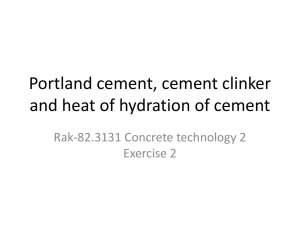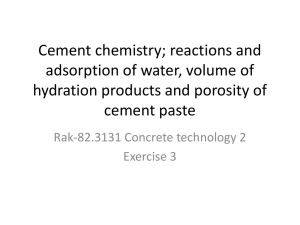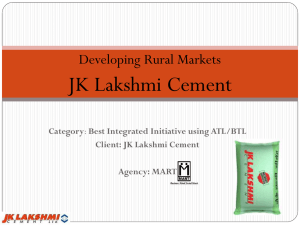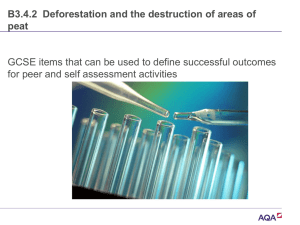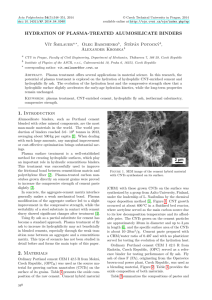C 3 A - CEProfs
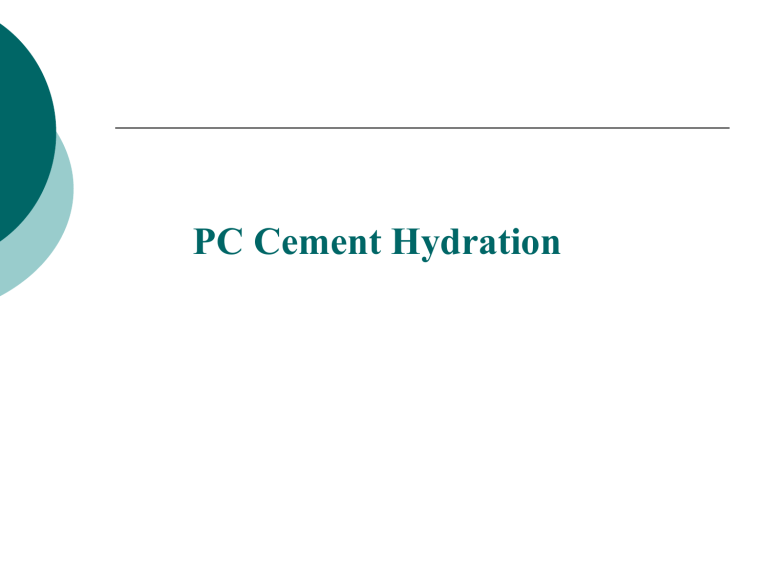
PC Cement Hydration
Introduction
Portland Cement Concrete
Continous binder phase : the cementitious matrix
•Binder effect on PCC behavior
Affects permeability
Affects strength
Dispersed particulate phase : the aggregates
•Coarse: #4 to 1½”
•Fine: #100 to #4
•Aggregates have a major effect on PCC behavior
Serve as a filler
Increase concrete modulus of elasticity
Cementitious Phase
•Portland Cement
•Water
•Admixtures
Liquid
Mineral
}
Workability
&
Strength
Cement Manufacture
•Quarrying – Raw materials
•Crushing
•Grinding
•Mixing
•Calcinated (1100
C)
•Burned (1450
C)
•Clinker is produced (10 mm size)
•Inter-ground with 5% gypsum (1-100 m)
- most reactive ( <50
m)
Hydration process
Hydration process
Setting – Solidification of the plastic cement paste
•Initial set – beginning of solidification – Paste become unworkable – loss in consistency - not < 45 min.
•Final set – Time taken to solidify completely – Not > 375min.
Hardening – Strength gain with time – after final set
Hydration - Exothermic
Reaction
2C
3
S + 11H C
3
S
2
H
8
+ 3CH
H = -500 J/g
2C
2
S + 9H C
3
S
2
H
8
+ CH
H = -250 J/g
Calcium silicates (C
3
S or C
2
S) + water
Calcium silicates hydrate (C-S-H) + calcium hydroxide
•Amount of
CH depends on proportion of C
3
S and C
2
S
•CSH
- amorphous in nature, is an inexact composition, and is extremely fine (Colloidal).
Tricalcium Aluminate (C
C
3
A + H
2
C
3
A + H
2
C
3
O
reacts very fast
O + CSH
A + 3CSH
2
2
(Gypsum)
reacts much slower
+ 26H
C
6
AS
3
H
32
H = -1350 J/g
3
A)
Tricalcium Aluminate + Gypsum + Water
Ettringite (product #3)
Once CSH
2
C
6
AS
3
H
32 is depleted:
+ 2C
3
A + 4H
3C
4
ASH
12
Ettringite + Tricalcium Aluminate + Water
Monosulfoaluminate (product #4)
Ferrite Phase: C
4
AF
•Forms same reaction as C
3
A but to a lesser degree
•Uses small amount of gypsum
C
4
AF + 2CH + 14H
C
4
(A,F)H
13
+ (A,F)H
3
Ferrite + Calcium Hydroxide + Water
Tetracalcium Hydrate + Ferric Aluminum Hydroxide
(product #5) (product #6) like monosulfoaluminate amorphous
Hydration of Portland cement
Sequence of overlapping chemical reactions
Hydration reactions of individual clinker mineral proceed simultaneously at differing rates and influence each other
A complex dissolution and precipitation process
Leading to continuous cement paste stiffening and hardening
Reaction rate: C3A > C3S > C4AF > C2S
Hydration of Portland cement
Reactivity
• Crystal size – Heating rate, burning temp.
• Crystal defects vs. impurities
• polymorphic form – rate of cooling
• Fineness e.g. C3S and C2S with impurities hydrate faster than their pure forms
Heat of hydration (Cal/g)
Compound 3 days 90 days 13 years
58 104 122 C
3
S
C
2
S
C
3
A
C
4
AF
12
212
69
42
311
98
59
324
102
Model of CSH
ASTM Types of Portland Cements
C3S
C2S
C3A
C4AF 8
Gypsum 5
I II III IV V
50 45 60 25 40
25 30 15 50 40
12 7 10 5 4
12
5
8
5
12
4
10
4
Fineness 350 350 450 300 350
(m2/kg)
CCS (psi) 1000 900 2000 450 900
330 250 500 210 250 Heat of
Hydration
(J/g)
I II III IV V
C
3
S 50 45 60 25 40
C
2
S 25 30 15 50 40
C
3
A 12 7 10 5 4
C
4
AF 8 12 8 12 10
Fine 350 350 450 300 350
Blended Cements
•20 to 70% of total binding material
•Total = Cement & supplementary cementitious material
•Most mineral admixtures are industrial by products
•Use is economical, ecological, or technical in nature
Fly ash: coal fired power plants
Blast furnace slag: steel production
•lower heat, improved durability
• Fine pore structure and lower permeability with same w/c
•Improve workability
Pozzolans
2S + 3CH + 7H
C
3
S
2
H
8
•First used by Romans
•CSH is of lower CaO content
•Low heat and slow strength gain
•Similar to increase in C
2
S
•Reactivity based on surface area (silica fume)
•Some contain alumina (can present durability problems)
•Crystalline compounds (quartz); acts to dilutents
•Unburned carbon may affect air entrainment
•Can have a wide range of composition and reactivity
Blast Furnace Slag
•Rapidly cooled slags - to prevent crystallization
•(CSA) glass
+ H
C
3
(SiA)
2
H
8
•Forms alumin substituted CSH
(self - reacting)
•Presence of CH accelerated reaction
•Mixed with cement
Porosity and pore structure
Capillary pores
Gel pores
Pore size distribution
2.5 nm
High strength and low permeability concrete
•
Low W/C ratio
Proper mixture proportioning
Use of superplasticizers
Use of pozzolans
•High degree of hydration
Good curing
